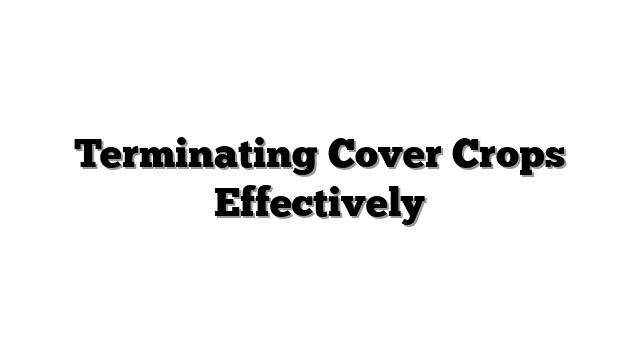Spring Cover Crop Management
Tired soil makes gardening hard. Weeds pop up everywhere. Your plants need more food. Does this sound like your garden? Many gardeners feel this way.
Healthy soil is the secret. Nature helps soil heal itself. Cover crops are nature’s helpers. They grow roots in winter. They protect the soil. They add good things.
Growing cover crops is good. Managing them matters too. Spring is the time for change. You must get cover crops ready. Ready for new plants.
Poor spring work hurts. It can stop good things. It can make planting tough.
This guide helps you. It shows you how. How to manage cover crops. Manage them this spring. For your home garden.
We cover important steps. Why spring work matters. When is the best time? How to stop cover crops. What to do with the leftover plants. How cover crops fit your year.
We talk about soil health. Good gardening ways. Helping your plants grow. Let’s make your garden great.
More than Just Mowing: Why Spring Cover Crop Management is Critical
Cover crops grow all winter. Or they grew last fall. Spring arrives. Your garden wakes up. You want to plant soon.
The cover crop is still there. It takes up space. You need that space. Space for your tomatoes. Space for your beans. You must move the cover crop.
Moving them is not enough. You must stop them growing. This is spring management. It is very important.
Why is it so key? Think about food. Cover crops hold food. Food from the soil. They store it in their leaves. Store it in their stems.
You stop the cover crop. It starts to break down. This is decomposition. The plant breaks apart. Tiny things in the soil eat it. Soil microbes eat it.
They release the food. Food goes back to the soil. Your new plants use this food. This is nutrient cycling. It feeds your vegetables. It feeds them naturally.
Timing the stop is key. It helps get food ready. Ready for planting time.
Cover crops fight weeds. They cover the ground. Weeds cannot grow easily. But cover crops can make seeds. They can make seeds quickly.
Stop them before seeds form. This is weed suppression. You stop new weeds. You keep the ground clean. If you wait too long? The cover crop becomes a weed.
Cover crops grow tall. They need water. They need sunshine. Your new plants need water. They need sunshine too.
Leaving cover crops alive means trouble. They take water. They take light. They compete with small plants. Stop them before you plant. Avoid this fight.
Roots work wonders underground. Cover crop roots break soil. They make paths for water. They make paths for air. This improves soil structure.
The leftover plant parts add organic matter. This is like soil food. Microbes eat it. It makes soil soft. It makes soil crumbly.
Proper spring work helps this. It feeds the soil life. Soil biology gets better. Healthy soil grows strong plants.
Look at your cover crop. See how it grows. This tells you things. It tells you when to act. When to start managing it. Pay attention to its stage.
Studies show soil health improves. One study saw better water holding. Another saw more earthworms. Earthworms are good soil helpers.
An expert once said, “Feed the soil, not the plant.” Cover crops feed the soil. Spring work helps finish the job.
The Golden Window: When to Terminate Cover Crops for Maximum Benefit
Knowing when to stop cover crops matters most. It is a golden window. Miss it, and things get harder.
The plant’s growth stage tells you. This is the main signal. Look at the cover crop carefully. What stage is it in?
Some cover crops are grasses. Like cereal rye. Some are legumes. Like field peas. They act differently.
Stop grasses before they make seeds. Often, this is before flowering. Or when they just start. Their stems get tough later. Tough stems break down slowly.
Legumes add nitrogen. This is plant food. They add the most nitrogen. They add it when they flower. Stop them when they start flowering. This gets you more nitrogen.
Think about your next crop. When will you plant it? This date is important. Work backward from this date.
You need a rest time. After you stop the cover crop. Before you plant new seeds. This rest time is needed.
Why a rest time? The plant parts break down. They need time. Decomposition happens now. Chemicals can also leave. Some plants release chemicals. These stop other plants. They need time to go away.
Two to four weeks is common. This waiting time helps. It depends on the method used. It depends on the cover crop. Fast breakdown means less wait.
Different plants grow differently. Winter rye grows fast in spring. It gets tall quickly. Field peas grow slower. They flower later. Know your cover crop type. Know its habits.
Weather changes things. A cold, wet spring slows things. It slows growth. It slows breakdown. You might wait longer.
A warm, dry spring is faster. Growth speeds up. Breakdown speeds up. Watch the weather report. Plan around it.
Your goal matters too. Do you want lots of plant stuff? Plant stuff for soil organic matter? Let it grow longer. Stop it later. Maybe when it starts flowering.
Do you need to plant early? Stop the cover crop early. Maybe before flowering starts. It will break down faster.
Stopping too early has risks. You get less plant stuff. Less stuff to feed the soil. Less nitrogen from legumes.
Stopping too late has risks. The plant gets tough. Harder to cut. Breaks down slowly. It might make seeds. Then you have new weeds. It competes with new plants.
Watch the growth stage closely. Check the weather forecast. Have a planting calendar ready. Maybe be a bit flexible.
A simple rule: Stop grasses before seeds form. Stop legumes as they start flowering. This captures many benefits.
“Observe nature,” one farmer said. “She tells you what to do.” Look at your plants. They give clues.
Your Toolkit for Termination: Effective Cover Crop Management Methods
You know why and when. Now, how do you stop cover crops? You have different tools. Different ways to do it.
Methods fall into groups. Mechanical methods use tools. Manual methods use your hands. Some methods use covering.
Mechanical methods use machines. Or garden tools.
Mowing is one way. You cut the plants down. A lawn mower works for small areas. A flail mower is stronger. It chops plants into small pieces.
Mow before plants make seeds. Or when they are short. It is simple to do. It leaves cut plants on top. This is good for the soil surface. But thick plants might regrow. Some tough plants survive mowing.
Rolling or crimping is another. You bend the stems hard. A roller or crimper tool does this. It breaks the stems. It stops water flow. This kills the plant.
Roll after plants flower. This is important. The plant is weaker then. This method is great for no-till. It leaves a mat of plants. This mat stops weeds. It protects the soil. You need the right tool though. Timing is very important for this.
Tilling mixes plants into soil. A garden tiller does this. It turns the soil over. It buries the cover crop. This speeds up breakdown. It makes a clean bed. Ready for seeds.
But tilling has downsides. It breaks soil structure. It harms soil biology. It can bring weed seeds up. Seeds buried deep now sprout. It is a trade-off. Tilling works. But other ways can be better. Better for soil life.
Manual methods are simple. Good for small gardens. Good for raised beds.
You can cut plants down. Use scissors. Use a scythe. Use garden shears. Chop them into pieces. Leave the pieces on top. Or put them in compost.
Tarping is another way. You cover the area. Use a large black tarp. Or thick plastic. This blocks sunlight. It heats the soil. It smothers the plants.
Tarping kills weeds too. It takes time. Maybe a few weeks. It needs the right material. But it does not need hard work. It is good for sustainable gardening.
Chemicals can kill plants. Herbicides kill plants. I do not suggest this for home gardens. Especially if you grow food. Chemicals can hurt soil life. They can hurt good bugs. They are not part of sustainable ways. Focus on other methods first.
Choose your method wisely. What cover crop did you grow? How big is your garden? What tools do you have? Do you want to dig? Or plant into a mat?
A small garden with peas? Cut them by hand. A large bed with rye? Maybe mow it first. Then cover it. A no-till plan with vetch? Try rolling it.
Think about your tools. Think about your goals. Pick the best way for you.
Here is a simple plan. Growing rye? Mow it when short. Or wait until it gets tall. Then roll it flat. Growing peas? Cut them down when flowering starts. Or till them under gently.
Studies show less tilling helps soil. One study saw more fungi. Fungi are good soil helpers. Less digging keeps them happy.
An expert on soil said, “Minimize disturbance.” That means less digging. Less turning the soil. Methods like rolling fit this idea.
From Residue to Ready Bed: Post-Termination Soil Preparation
You stopped the cover crop. Now you have plant leftovers. This is called residue. What happens next? Getting the soil ready is key.
The amount of residue changes. It depends on the cover crop. It depends on the method used. Mowing leaves cut stems. Rolling leaves a flat mat. Tilling mixes everything in.
The waiting period is important. Remember the 2-4 weeks? This is for decomposition. The residue breaks down. It becomes part of the soil. It adds organic matter.
This wait helps soil settle. It lets water spread out. It lets air get in. It also lets those chemicals go away. The ones some plants make.
Do you practice no-till? You will plant into the residue. The mat of dead plants stays there. This is good. It keeps weeds down. It holds water in the soil. It protects the soil surface.
How do you plant? Use a hand trowel. Make a small hole. Push the residue aside. Drop your seed in. Or put your small plant in. Cover it with soil. The residue stays around it.
This way keeps soil life happy. It does not disturb the soil biology much. It is a sustainable way. It is no-till cover crop management.
Did you till the cover crop in? The soil looks clean. It looks ready. But it needs to settle. Let it sit for a couple weeks. This helps air pockets go away. It makes a smooth seedbed.
Rake the top gently. Make it even. This helps small seeds sprout. They need good contact. Contact with the soil. This is soil preparation.
Sometimes residue is thick. Too thick to plant through. What can you do? Chop it finer first. Mow it again. Or use shears.
Is it breaking down slowly? Maybe the plants were tough. Or the soil is cold. Add some nitrogen. Like compost. Or a little organic fertilizer. This helps the microbes. They eat the plant stuff faster.
Sometimes you must rake. Rake some residue aside. Make a clear row. Plant your seeds there. Then put the residue back. Put it around the new plants.
How do you know soil is ready? Check the moisture. Squeeze a handful. It should stick together. Not drip water. Not fall apart dry.
Check the temperature. Use a soil thermometer. Different plants need different warmth. Wait until it is right. Right for your seeds. Right for your plants.
Here is a checklist. If you tilled: Wait 2-3 weeks. Rake the top smooth. Check the soil moisture. Then plant. If you crimped: Wait 1-2 weeks. Use a trowel. Plant right into the mat. Check moisture too.
A garden expert shared this. “Soil speaks to you,” she said. “Feel it. Smell it. Watch it.” Learn what healthy soil feels like.
Studies show soil health improves. Year after year. With cover crops. With good residue work. The soil gets darker. It holds more water. It becomes more alive.
Beyond Spring: Weaving Cover Crops into Your Yearly Garden Strategy
Spring work is a step. It is part of a bigger plan. Your whole gardening year. Thinking ahead helps a lot.
Planning starts before spring. What cover crop will you plant? Plant it in the fall. Or even late summer. Choose the right one. One that fits your goals. One that fits your climate. This makes spring easier.
Some cover crops die in winter. Frost kills them. They are easy to manage. Others live through winter. Like rye or vetch. These need spring work. Pick one that fits your plan.
Crop rotation is important. You move your plants each year. Don’t plant tomatoes in the same spot. Cover crops fit this idea. Rotate your cover crops too.
Plant legumes one year. Plant grasses the next. This helps soil health. Different plants help soil differently. This is crop rotation. It keeps soil healthy.
Using cover crops is long term. It is not a one-time fix. Do it year after year. Soil health builds up. Organic matter increases. Soil structure gets better.
You need less fertilizer. You have fewer weeds. Plants are stronger. This is sustainable gardening. It helps the earth. It helps your food grow well.
Sometimes things go wrong. The cover crop did not grow well. Or it was hard to kill. This happens. Learn from it.
Keep a garden journal. Write down what you planted. Write when you stopped it. Write what method you used. How did the soil look? How did the next plants grow?
This helps you plan better. Plan for next year. Adjust your methods. Try something new. Gardening is always learning.
Think about 2025. People care about soil more. They care about sustainable gardening. Cover crops are a big part. They help soil live. They help the planet.
Using cover crops is modern. It is good for you. It is good for the earth. It is a smart gardening technique.
An old saying goes, “The best fertilizer is the gardener’s shadow.” This means watching things closely. Watching your cover crops. Watching your soil. It pays off.
Your Spring Cover Crop Management Questions, Answered
Many gardeners have questions. Questions about spring cover crops. Here are some common ones.
What is the best time to kill my cover crop in the spring?
Look at the plant stage. This is most important. Stop grasses before seeds form. Stop legumes when flowering starts. Also, think about planting. Stop them 2-4 weeks before you plant.
Can I just till my cover crop into the soil right before planting?
You can till it in. But wait a few weeks. Waiting helps it break down. It helps soil settle. Planting right after tilling can hurt seeds. Some cover crops stop other plants. Waiting helps these chemicals go away. This is soil preparation.
How long after terminating a cover crop should I wait before planting?
Wait 2 to 4 weeks. This is a good rule. It gives time for breakdown. Time for the soil. The exact time changes. It depends on your method. It depends on the cover crop type. It depends on the weather. This is part of planting season plans.
My cover crop is regrowing after I terminated it. What did I do wrong?
This happens sometimes. Some plants are tough. Maybe you stopped it too early. Before it was weak. Maybe the method was not strong enough. Rolling works best after flowering. Mowing needs follow-up sometimes. Learn from it. Try a different method next time.
Do cover crops replace the need for compost or fertilizer?
Cover crops add food. They add organic matter. They help soil fertility. They cycle nutrients. This means you need less. Less compost. Less fertilizer. But they might not be enough. Especially for plants needing lots of food. They greatly improve soil. They work with compost. They do not always replace everything.
Mastering Spring Cover Crop Management for a Thriving Garden
Spring cover crop management matters. It helps your garden greatly. You unlock cover crop benefits.
You learn why it is needed. Making space for new plants. Feeding the soil. Stopping weeds later.
You learn when to act. The plant’s stage is key. Your planting date matters.
You learn how to stop them. Mowing, rolling, tilling. Covering the soil. Pick the best way for you.
Good management leads to good soil. Soil health improves. You get more organic matter. Your soil structure gets better.
This means healthier plants. Plants grow stronger. Plants are more productive.
It is part of gardening well. Part of gardening sustainably. It helps your garden thrive.
Try these steps this spring. See the difference it makes. Your soil will thank you. Your plants will too.
Read about choosing cover crops. Learn about different types. Explore organic gardening ways. We can help you more. Share your garden story with us.






